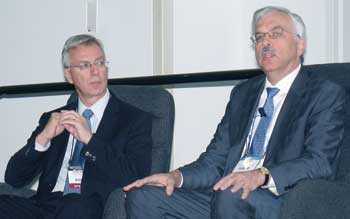By Paul Scott Abbott, AJOTFrom a major soft drink firm to the leading U.S. home appliance retailer to the top supplier of McDonald’s restaurants, intermodal rail service is providing a timely means to cost-effectively meet increasingly demanding consumer expectations.
 (L to R) Fernando Cortes, senior VP for supply chain and logistics at Dr Pepper Snapple Group; Brian Hancock, president of North American operations, The Martin-Brower Co.; Rick Smith, VP of transportation at Sears Holdings Corp.
(Photo by Paul Scott Abbott, AJOT)
(L to R) Fernando Cortes, senior VP for supply chain and logistics at Dr Pepper Snapple Group; Brian Hancock, president of North American operations, The Martin-Brower Co.; Rick Smith, VP of transportation at Sears Holdings Corp.
(Photo by Paul Scott Abbott, AJOT)
Logistics executives from those three companies were among speakers praising the benefits of intermodal transportation as the business program of the Intermodal Association of North America’s 30th Intermodal Expo and the National Industrial Transportation League’s 105th annual meeting and 30th TransComp Exhibition kicked off Nov. 12 in Anaheim, Calif.
Fernando Cortes, senior vice president for supply chain and logistics at Dr Pepper Snapple Group Inc., said his firm has come to depend upon intermodal for on-time delivery and reliability for virtually all moves of 500 miles or more of its beverage products. He added that railroads now should focus upon further reducing the number of miles at which intermodal service becomes cost-competitive with trucking.
Rick Smith, vice president of transportation at Sears Holdings Corp., said his company, which operates Sears and Kmart stores and is the biggest seller of appliances to U.S. homes, typically looks to intermodal for longer hauls but has come to use the Florida East Coast Railway for overnight delivery of appliances from a Jacksonville warehouse to Miami, just 350 miles to the south.
Brian Hancock, president of North American operations for The Martin-Brower Co., the world’s No. 1 dedicated distributor to McDonald’s restaurants, said he believes shippers will turn to intermodal even more as the Compliance Safety Accountability program and other Federal Motor Carrier Safety Administration initiatives lead to additional reductions in the number of available truck drivers.
Cortes, Smith and Hancock concurred that today’s customers are demanding more immediate deliveries while, at the same time, as Smith put it, “The consumer is never willing to pay more.”
That, they said, is why intermodal, with its growing dependability and lower costs, is becoming the transport means for choice for a growing number of shipments.
Intermodal transport also is the key to the rise of Canadian and Mexican gateways in serving U.S. heartland markets, as speakers in another Nov. 12 session pointed out.
Don Krusel, president and chief executive officer of the Prince Rupert Port Authority, said his burgeoning British Columbia port, in conjunction with Canadian National Railway Co., furnishes an ideal alternative to U.S. West Coast ports for getting imports from Asia to central U.S. consumers.
“We offer speed and reliability,” Krusel said.
Jean-Jacques Ruest, CN’s executive vice president and chief marketing, commented, “Supply chains more and more have no border.”
 (L to R) Jean-Jacques Ruest, executive VP & chief marketing officer of Canadian National Railway and Don Krusel, president & CEO of the Prince Rupert Port Authority
(Photo by Paul Scott Abbott, AJOT)
(L to R) Jean-Jacques Ruest, executive VP & chief marketing officer of Canadian National Railway and Don Krusel, president & CEO of the Prince Rupert Port Authority
(Photo by Paul Scott Abbott, AJOT)
Brian Bowers, senior vice president for intermodal and automotive at Kansas City Southern, said that, while the Port of Lazaro Cardenas, on Mexico’s Pacific Coast, originally was designed to deliver cargo to Mexican markets, it is ideally situated to bring in goods from both Asia and South America for U.S. consumers.
“It’s an unbelievable opportunity,” Bowers said of the prospects for serving U.S. consumers via Lazaro Cardenas and intermodal service crossing the Mexico-U.S. border.

 (L to R) Fernando Cortes, senior VP for supply chain and logistics at Dr Pepper Snapple Group; Brian Hancock, president of North American operations, The Martin-Brower Co.; Rick Smith, VP of transportation at Sears Holdings Corp.
(Photo by Paul Scott Abbott, AJOT)
(L to R) Fernando Cortes, senior VP for supply chain and logistics at Dr Pepper Snapple Group; Brian Hancock, president of North American operations, The Martin-Brower Co.; Rick Smith, VP of transportation at Sears Holdings Corp.
(Photo by Paul Scott Abbott, AJOT)
 (L to R) Jean-Jacques Ruest, executive VP & chief marketing officer of Canadian National Railway and Don Krusel, president & CEO of the Prince Rupert Port Authority
(Photo by Paul Scott Abbott, AJOT)
(L to R) Jean-Jacques Ruest, executive VP & chief marketing officer of Canadian National Railway and Don Krusel, president & CEO of the Prince Rupert Port Authority
(Photo by Paul Scott Abbott, AJOT)





